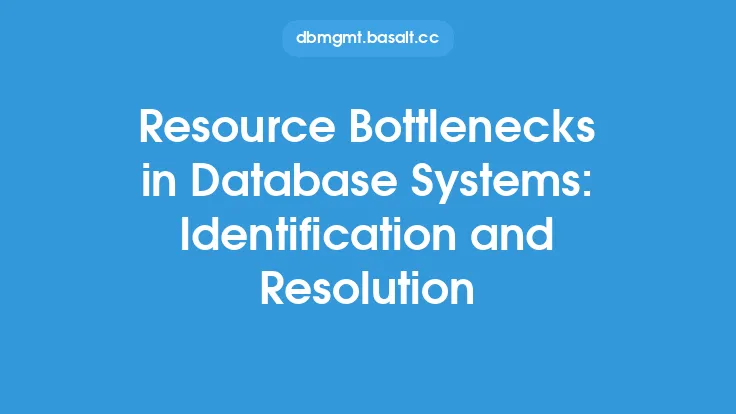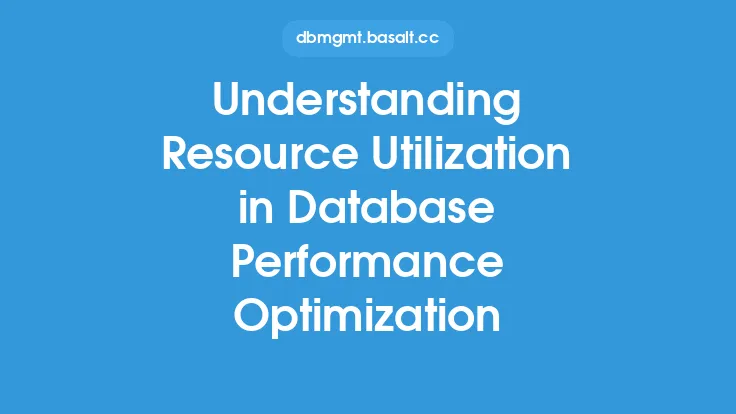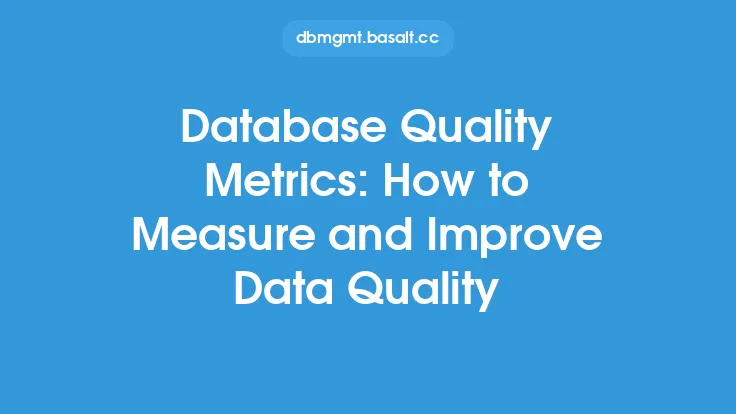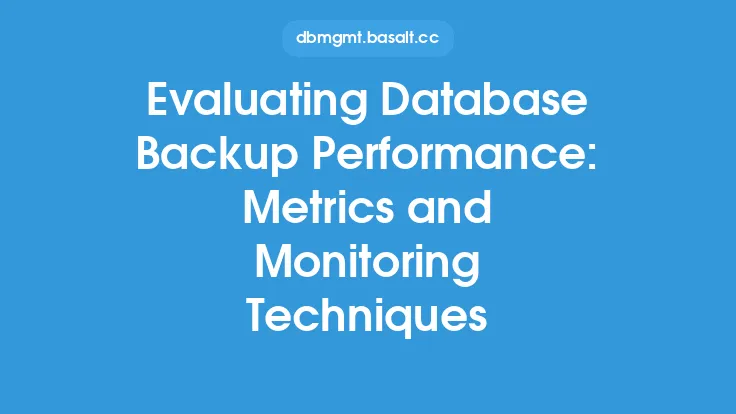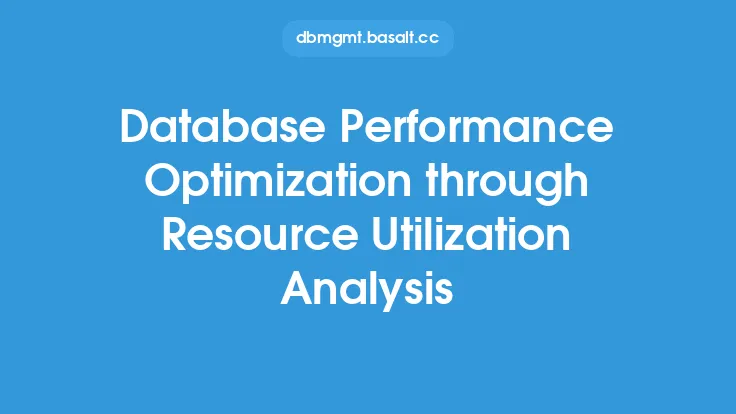Database performance is heavily dependent on the efficient utilization of resources. Resources such as CPU, memory, disk space, and network bandwidth are essential for a database to operate smoothly. In order to optimize database performance, it is crucial to monitor and measure resource utilization. This involves tracking various metrics that provide insights into how resources are being used, identifying areas of inefficiency, and making adjustments to improve resource allocation.
Introduction to Database Resource Utilization Metrics
Database resource utilization metrics are used to measure the usage of resources such as CPU, memory, disk space, and network bandwidth. These metrics provide valuable insights into how resources are being utilized, helping database administrators to identify areas of inefficiency and optimize resource allocation. Common database resource utilization metrics include CPU usage, memory usage, disk usage, and network usage. These metrics can be measured using various tools and techniques, including database management system (DBMS) built-in tools, third-party monitoring tools, and operating system-level tools.
Measuring CPU Usage
CPU usage is a critical metric in database resource utilization. It measures the percentage of time the CPU is busy executing instructions. High CPU usage can indicate poor query optimization, inadequate indexing, or insufficient CPU resources. To measure CPU usage, database administrators can use DBMS built-in tools such as Oracle's Enterprise Manager or Microsoft's SQL Server Management Studio. Third-party monitoring tools such as Nagios or SolarWinds can also be used to measure CPU usage. Additionally, operating system-level tools such as Windows Performance Monitor or Linux's top command can be used to measure CPU usage.
Measuring Memory Usage
Memory usage is another important metric in database resource utilization. It measures the amount of memory used by the database. Insufficient memory can lead to performance issues, while excessive memory usage can indicate memory leaks or inefficient memory allocation. To measure memory usage, database administrators can use DBMS built-in tools such as Oracle's Enterprise Manager or Microsoft's SQL Server Management Studio. Third-party monitoring tools such as Nagios or SolarWinds can also be used to measure memory usage. Additionally, operating system-level tools such as Windows Performance Monitor or Linux's top command can be used to measure memory usage.
Measuring Disk Usage
Disk usage is a critical metric in database resource utilization. It measures the amount of disk space used by the database. Insufficient disk space can lead to performance issues, while excessive disk usage can indicate inefficient data storage or indexing. To measure disk usage, database administrators can use DBMS built-in tools such as Oracle's Enterprise Manager or Microsoft's SQL Server Management Studio. Third-party monitoring tools such as Nagios or SolarWinds can also be used to measure disk usage. Additionally, operating system-level tools such as Windows Performance Monitor or Linux's df command can be used to measure disk usage.
Measuring Network Usage
Network usage is an important metric in database resource utilization. It measures the amount of network bandwidth used by the database. High network usage can indicate excessive data transfer, while low network usage can indicate underutilization of network resources. To measure network usage, database administrators can use DBMS built-in tools such as Oracle's Enterprise Manager or Microsoft's SQL Server Management Studio. Third-party monitoring tools such as Nagios or SolarWinds can also be used to measure network usage. Additionally, operating system-level tools such as Windows Performance Monitor or Linux's iftop command can be used to measure network usage.
Analyzing Database Resource Utilization Metrics
Analyzing database resource utilization metrics is crucial to identifying areas of inefficiency and optimizing resource allocation. Database administrators can use various techniques to analyze these metrics, including trend analysis, threshold analysis, and correlation analysis. Trend analysis involves analyzing metrics over time to identify patterns and trends. Threshold analysis involves setting thresholds for metrics and alerting when these thresholds are exceeded. Correlation analysis involves analyzing the relationship between different metrics to identify areas of inefficiency.
Using Database Resource Utilization Metrics to Optimize Performance
Database resource utilization metrics can be used to optimize database performance. By analyzing these metrics, database administrators can identify areas of inefficiency and make adjustments to improve resource allocation. For example, high CPU usage can indicate poor query optimization, and database administrators can use this information to optimize queries and improve performance. Similarly, high memory usage can indicate memory leaks or inefficient memory allocation, and database administrators can use this information to optimize memory allocation and improve performance.
Best Practices for Measuring Database Resource Utilization
Measuring database resource utilization requires careful planning and execution. Database administrators should follow best practices such as monitoring metrics regularly, analyzing metrics in real-time, and using automated tools to collect and analyze metrics. Additionally, database administrators should set thresholds for metrics and alert when these thresholds are exceeded. This ensures that database administrators can quickly identify areas of inefficiency and make adjustments to improve resource allocation.
Common Challenges in Measuring Database Resource Utilization
Measuring database resource utilization can be challenging. Common challenges include data overload, metric complexity, and tool limitations. Data overload occurs when there is too much data to analyze, making it difficult to identify areas of inefficiency. Metric complexity occurs when metrics are difficult to understand, making it challenging to analyze and interpret them. Tool limitations occur when tools are not capable of collecting and analyzing metrics, making it difficult to measure database resource utilization.
Future of Database Resource Utilization Measurement
The future of database resource utilization measurement is likely to involve advanced technologies such as artificial intelligence (AI) and machine learning (ML). These technologies can be used to analyze metrics in real-time, identify areas of inefficiency, and make adjustments to improve resource allocation. Additionally, cloud-based monitoring tools are likely to become more prevalent, making it easier to measure database resource utilization and optimize performance. As databases continue to evolve and become more complex, the importance of measuring database resource utilization will only continue to grow.

